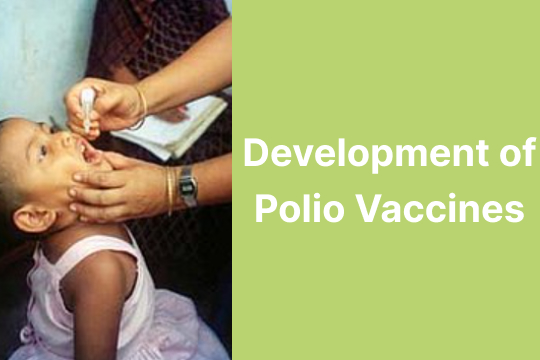Development of Polio Vaccines
Summery
The development of polio vaccines is a critical milestone in the field of public health. It led to the near-eradication of polio, a highly contagious and crippling disease caused by the poliovirus. The two most well-known polio vaccines are the inactivated polio vaccine (IPV) and the oral polio vaccine (OPV).
The IPV was developed by Jonas Salk and introduced in the 1950s. It is an injectable vaccine that contains inactivated (killed) poliovirus and is highly effective in preventing polio.
The OPV, developed by Albert Sabin, came later and was administered orally. It uses weakened live poliovirus to stimulate immunity. Both vaccines have played a significant role in reducing polio cases worldwide.
The development of these vaccines involved extensive research, testing, and clinical trials. Their success represents a significant achievement in the history of medicine, as they have saved countless lives and prevented widespread suffering from polio.
Please note that this is a general summary of the topic, and specific details may vary depending on the source and the focus of the article by Bonnie A.M. Okonek and Linda Morganstein. If you would like more information or a detailed summary of a specific article or publication, I recommend accessing the article directly or consulting an academic database or library.
Question And Answer
unit-1
What is poliomyelitis?
Answer: Poliomyelitis, commonly known as polio, is an acute, viral, and infectious disease that has the potential to cause lifelong paralysis. It is primarily transmitted through the fecal-oral route and can lead to severe disability or even death.
When did Franklin D. Roosevelt realize that he had contracted polio?
Answer: After engaging in physical activities like swimming, Franklin D. Roosevelt began to experience symptoms of illness, including feeling cold. Within a few days, he came to the unequivocal conclusion that he was suffering from polio.
What are the early symptoms associated with a polio infection?
Answer: The initial symptoms of a polio infection often resemble those of the flu. These symptoms may include a headache, nausea, vomiting, and fever.
What can serve as carriers of the poliovirus?
Answer: The poliovirus can be carried by various means, including droplets of water or fluids in the air. Additionally, the virus can be present in the fecal matter of infected individuals, posing a significant source of transmission.
What percentage of people infected with the poliovirus develop severe polio symptoms?
Answer: Approximately 10% of individuals infected with the poliovirus will develop symptoms, and only around 1% of those symptomatic cases will experience permanent limb paralysis due to the disease.
What are the two primary forms of polio?
Answer: Polio manifests in two main forms: the spinal form and the bulbar form.
Are the symptoms of the spinal and bulbar forms of polio similar or distinct? Which form is considered more dangerous?
Answer: The symptoms of the spinal and bulbar forms of polio differ significantly. The spinal form primarily affects the limbs, while the bulbar form primarily affects the respiratory system, particularly the lungs. Both forms can be dangerous, but the bulbar form, with its potential to cause respiratory paralysis, is often considered more severe and life-threatening.
unit-2
Did polio have a significant impact on Franklin D. Roosevelt’s political career?
Answer: Polio had a limited impact on Franklin D. Roosevelt’s political career. He persevered through his affliction and continued to fulfill his political duties effectively.
What was the highest political office that Franklin D. Roosevelt achieved in his career?
Answer: Franklin D. Roosevelt reached the pinnacle of American politics by becoming the President of the United States.
How did Franklin D. Roosevelt lead the fight against polio?
Answer: Franklin D. Roosevelt played a crucial role in raising awareness about polio among the public, advocating for preventative measures. He also established funds for research to develop treatments and vaccines to combat the disease at its source.
Who is most vulnerable to polio?
Answer: Young children, particularly those living in unsanitary environments, are the most vulnerable to contracting polio.
Why were parents in the early 1950s apprehensive about sending their children to school?
Answer: In the early 1950s, parents were concerned that sending their children to school might expose them to infections, including polio, from other children, leading to apprehension about attending school.
unit-3
Why did early attempts at developing a polio vaccine fail?
Answer: Early attempts at developing a polio vaccine failed because researchers were unaware that the polio virus had three distinct strains. Merely targeting one strain with a vaccine was insufficient to provide immunity against all forms of the disease.
Why were some children immune to polio before the 1900s?
Answer: Prior to the 1900s, lack of knowledge about the importance of sanitation practices allowed the polio virus to spread easily and infect young children. However, some children managed to develop natural immunity by producing antibodies against the virus when infected. Girls with these antibodies, who later became mothers, passed on their immunity to their babies through breastfeeding. This natural process conferred immunity to some children.
Did improved sanitation contribute to the prevention of polio before the 1900s?
Answer: Yes, improved sanitation practices played a significant role in reducing the incidence of polio before the 1900s. These practices helped in minimizing the spread of the polio virus.
How did the March of Dimes contribute to the effort to eliminate polio?
Answer: Researchers funded by the March of Dimes conducted extensive research into the complexities of polio and ultimately succeeded in developing a vaccine that could effectively combat all strains of the polio virus. This groundbreaking vaccine was a significant achievement in the fight against polio.
unit-4
What method did Jonas Salk employ to develop the polio vaccine?
Answer: In 1952, Jonas Salk pioneered the development of a successful polio vaccine by creating a mixture of the three types of poliovirus, which were cultured in monkey kidney cells. He used formalin, a chemical, to inactivate the entire virus.
How did Jonas Salk achieve the development of a successful vaccine?
Answer: Initial field trials of the original Salk vaccine had mixed results, with 260 cases of vaccine-induced polio and 10 fatalities. The issue was traced back to incomplete inactivation of some virus particles, which was promptly addressed. Subsequently, the vaccine has been highly effective, providing protection rates ranging from 70% to 90%.
How was the first polio vaccine received by the public?
Answer: The first polio vaccine underwent extensive large-scale clinical trials in the United States and parts of Canada in 1954. The results of these trials were remarkably positive, with a noticeable decline in polio cases among vaccinated individuals. Consequently, in 1955, the government granted permission for the vaccine to be distributed to children across the country.
What was the initial problem with the original Salk vaccine?
Answer: The initial problem with the original Salk vaccine was its relatively low success rate, coupled with a high number of deaths following vaccination. This issue was attributed to incomplete inactivation of some virus particles in the vaccine, but it was later rectified. Subsequent versions of the vaccine proved highly effective, with protection rates of 70% to 90%.
How was the Salk vaccine administered?
Answer: The Salk vaccine is administered through two intramuscular injections, which are spaced one month apart. It also requires periodic booster shots every five years. However, organizing the necessary syringes and needles for mass vaccination campaigns can be both expensive and logistically challenging.
What are the advantages of an oral vaccine, like the Sabin vaccine?
Answer: Oral vaccines, such as the Sabin vaccine, are convenient and cost-effective to administer, as they involve a few drops placed in a child’s mouth.
What is the major drawback of the Sabin oral vaccine?
Answer: The primary disadvantage of the Sabin oral vaccine is that it contains a live virus, making it unsuitable for individuals with compromised immune systems, as it can cause disease in these individuals. Additionally, those in close contact with immune-compromised patients should avoid the vaccine, as the live virus can be shed in the feces of those who ingest it, increasing the risk of transmission. Another drawback is that individuals with a preexisting enterovirus infection of the gastrointestinal tract when taking the oral vaccine may not develop the desired immune response.
unit-5
What factors can enhance the production of antibodies?
Answer: More effective culturing and purification techniques are factors that can enhance the production of antibodies.
What is the most recent development in polio vaccine research?
Answer: The latest research in the development of polio vaccines involves using Escherichia coli, a common bacterium found in the human gastrointestinal tract, as a medium to produce a more efficient polio vaccine.
Is the complete eradication of poliomyelitis achievable?
Answer: Yes, complete eradication of poliomyelitis is possible.
We sincerely appreciate your time and interest in our content Development of Polio Vaccines . Your support means the world to us, and we’re thrilled that you chose to visit our page.
At AskXYZ, we’re committed to delivering valuable and engaging content. We want to ensure that your experience with us is exceptional. That’s why we invite you to explore more of our posts/articles. We’re confident you’ll find something that piques your interest.
Your feedback is incredibly important to us. It helps us understand what you love and how we can improve. Please take a moment to share your thoughts or suggestions. We’re all ears!
Explore our other posts/articles and share your feedback with us .






